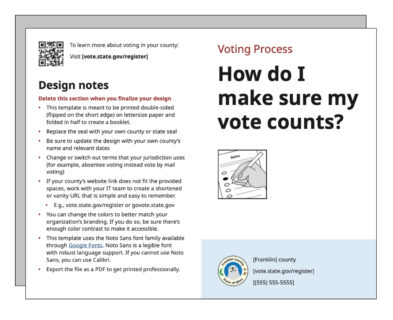Too much info? Break it into bites, snacks, and meals
At CCD, we love to use bite-snack-meal to organize information. We use it in our workshops, and it’s the framework behind the new EAC Voter Education Design Toolkit. Let’s dive into the details of what it is and how you can use bite-snack-meal in your voting communication materials.
Bite-snack-meal breaks the information down into 3 different sizes:
A “Bite” is the smallest piece of information that tells voters the critical steps they need to take action.
An example of a bite: Registration deadline and where to register
A “Snack” adds more context. A “snack” is usually just enough information for experienced voters.
An example of a snack: What you need to register to vote
The “Meal” has everything, including information about particular situations that only apply to some voters. It’s usually a webpage or a written voter guide.
An example of a meal: Detailed instructions on how and where to register, eligibility, etc.
How to use bite-snack-meal for your voter communication materials
As a framework for organizing information, bite-snack-meal can be adapted to different voter materials, either as you are creating them or for materials you already have.
If you already have specific voter material and you want to make it more effective, bite-snack-meal can help you take a step back and organize the information.
The Voter Education Design Toolkit makes it easy for you to get started
In the new Voter Education Design Toolkit we’ve included ready-made “bites,” “snacks,” and “meals” of voter information for you to start using right away.
A bite might be a social media template that highlights a date for a call to action. Typically, a bite includes a link for voters to find more information. This helps direct those who want to learn more to the information they need, but it keeps the material clear and easy to digest for everyone else.
The snack is a longer postcard reminding people to register to vote. The snack also directs voters to find even more information that might be relevant to them, without overwhelming the flyer itself.
And the meal answers voter’s questions, for example in a booklet.

How to get started
Practically any message or information can be broken into bites, snacks, and meals. It’s also about how and when you’re communicating that information, not just what you want to say. Making election information digestible is an essential part of getting your message across.
If you’re creating new voter materials, you can incorporate the 3 levels of information into your communication plan from the beginning. The bite-snack-meal approach can help you plan out the sequence of your communication materials with voters.
Our toolkit for designing impactful voter materials also uses the bite-snack-meal communication strategy to help you map out your materials.
How to identify “the bite”
The best way to identify the bite is to put all of the information you’re trying to communicate in one place, and then take a step back and ask yourself which part is the most essential. If voters only take one thing away from reading your material, what should it be? Maybe it’s the deadline to register to vote. Maybe it’s the dates of the election. Another question you can ask yourself is, “What do you want voters to do with the information?” When you’ve found this, you’ve identified the bite!
Once you have the bite identified, it’s a lot easier to build out the snack, by adding in a bit more context. The meal is the full amount of information, which is essentially the material you started with.
Learn more about the EAC Voter Education Design Toolkit
You’ll find customizable templates for different voter materials in the EAC Voter Education Design Toolkit, whether it’s a bite, snack or a meal. The toolkit also includes best practices for using bite-snack-meal as well as editable content for 4 common voter education topics:
- Voter Registration
- Voting Options
- Voting Process
- Voters with Specific Circumstances
We would love to hear your questions about any part of the process. Reach out to us at hello@civicdesign.org or reply to this email.

